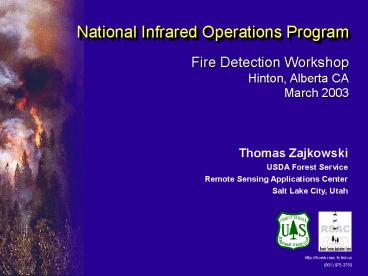National Infrared Operations Program - PowerPoint PPT Presentation
1 / 33
Title:
National Infrared Operations Program
Description:
28,000 firefighters and support personnel were assigned to fire suppression ... Over 778 missions flown. 1400 flight hours. Peak 29 fires per night. 17 107Z. 12 100Z ... – PowerPoint PPT presentation
Number of Views:22
Avg rating:3.0/5.0
Title: National Infrared Operations Program
1
National Infrared Operations Program
Fire Detection Workshop Hinton, Alberta CA March
2003
Thomas Zajkowski USDA Forest Service Remote
Sensing Applications Center Salt Lake City, Utah
http//fsweb.rsac.fs.fed.us (801) 975-3750
2
2002 Wildland Fire Season
- Even though 99 of all fires were suppressed in
initial attack, 609 of 68,230 fires became large
fire incidents - 28,000 firefighters and support personnel were
assigned to fire suppression activities by early
July - International support came from Australia, New
Zealand, and Canada
3
U.S. Fire History
2002 Fire Season is approximately 6,700,000 acres
4
Fire Costs by Federal Agency
5
Background
- forest fire detection is not a simple thermal
mapping job. To be effective, this system must
find the fire targets when they are very small
and distributed over vast land areas. The fire
targets must be precisely located to be of any
use to fire suppression forces. - Airborne Infrared Forest Fire Detection System
Final Report, 1971.
6
Forest Service and IR
- First project, FireScan began in 1962
- Continuous operational deployment since 1967
- Development of Mouse Trap FLIR 1984
- Numerous papers, and technical reports
- Continuous evaluation of commercial, scientific,
and military systems
7
National Infrared Operations Program
- Based at the National Interagency Fire Center in
Boise ID. - Presently there are 2 aircraft and 3 sensors
- Full time staff consists of 2 IR technicians, and
4 pilots. - During the summer 4 IR technicians and nearly 200
Infrared interpreters help collect and interpret
the data.
8
National Infrared Operations Program
- 2002 statistics
- Over 778 missions flown
- 1400 flight hours
- Peak 29 fires per night
- 17 107Z
- 12 100Z
- Average 3 to 5 missions per aircraft
- Nearly 85 of all request were accomplished.
9
Cessna Citation Bravo N100Z
NIROPS Aircraft
Beechcraft King Air 200 N107Z
10
Aerial Line Scanning
11
FLAME Fire Logistics Airborne Mapping
EquipmentEarly 1980s
-------- RS-25 -------- --------- FLAME
---------
- FLAME
- Completely analog system
- Output is 5-inch film strips
12
Phoenix DSP Early 2000s to Future
------------ Phoenix DSP -----------
------------ RS-25 ------------
Strip Charts
Digital Processing
Data Logs
PC
Rectified Images
A/D and DSP
3-5µm, 8-12µm detectors
IR Scanner
120 FOV 200 lps
- Phoenix DSP
- Removes all analog electronics now completely
digital - Integrates wider FOV scanner
- Moves some image processing to ground computers
dual outputs - Replaces gyros/inclinometers with integrated
GPS/IMU
13
Phoenix IntegrationCessna Citation Bravo N100Z
14
(U) Forest Service Airborne Thermal Imagery
15
PHOENIX Imagery
1670 Pixels Wide by XXX Long GeoTIFF file format
16
Why a Typing Scheme NOW?
- Requested by Incident Commanders
- Need to know which Infrared System to choose for
a particular situation. - IR is not IR
- Save time and money!
17
Typing System. What is it good for?
- Sets realistic expectation of IR
technology for Incident Commanders. - Defines a common language between firefighters
and technical staff - Sets Guidelines for what is expected from a
vendor.
18
What it is NOT!
- Rigid regulations
- Hindrance to technology development
- Barriers for commercial vendors
19
Based on the helicopter typing scheme
- Three types
- Based on fire detection sensitivity, area
coverage, and data products. - Modifiers designate special capabilities
20
IR Typing Criteria
- Viewing
- Spatial Resolution
- Positional Accuracy
- Fire Detection Sensitivity
Modifying Criteria
Real time downlink Digital output Airdrops Day
only Night only 3-5 micron band 8-14 micron band
- Fire Detection Accuracy
- Production
- Over Sampling
- Bands
- Product(s)
21
Type 3
- Single band usually 3-5 or 8-12 um
- Might not have any data output other than what
shows up on the units display
Three categories Type 3c Handheld units Type 3b
Without geo-correction Type 3a With
geo-correction
22
Truloves Favorite Soap Box
- Potential data error
- No way to check data
- Laser ranging or other means of geo-locating the
fire
23
FLIR
Line Scanner
24
Type 2
- Typically mounted on fixed wing aircraft
- Nadir viewing
- Higher production rates than Type 3 sensors
- More than on band although usually only one
thermal band - Focal plane arrays, multi-camera systems, line
scanners
25
Geo-correcting Imagery
- Must solve for six degrees of freedom
- X,Y, and Z position in space
- Roll, Pitch, and Yaw
26
Geo-correcting Imagery
- One more thing needed
- Digital Elevation Model (DEM)
27
Private Sector Thermal Imaging SystemHayman
Fire, Colorado - 19 June 2002
28
Private Sector Thermal Imaging SystemHayman
Fire, Colorado 19 June 2002
29
Private Sector Thermal Imaging System Hayman
Fire, Colorado 19 June 2002
30
Coverage of Thermal Imaging Systems Hayman Fire,
Colorado 19 June 2002
Forest Service National Airborne System Swath
Width
Private Sector System Swath Width
31
Type 1
- Highest production rates
- Multi-thermal bands
32
Thermal Infrared Why two bands?
Two bands of interest 3-5 micron, and 8-14
micron
3-5 micron band is much more sensitive to hot
fire, but becomes saturated easily loss of
background detail 8-14 micron band better for
background terrain, but not as sensitive to fire.
33
Questions/Discussion































